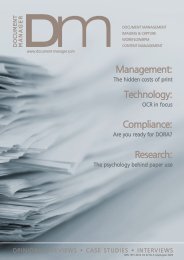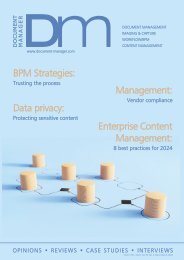DM Jan-Feb 2024
You also want an ePaper? Increase the reach of your titles
YUMPU automatically turns print PDFs into web optimized ePapers that Google loves.
MARKET FOCUS: HEALTHCARE Dm<br />
"THE INTEGRATION OF BOTH TECHNICAL AND SEMANTIC STANDARDS IS OBVIOUSLY DECISIVE IN IMPLEMENTING<br />
EFFICIENT AND EFFECTIVE DIGITAL PATIENT RECORDS. IN THIS CONTEXT, ANOTHER VERY PROMINENT EXAMPLE FOR<br />
SEMANTIC STANDARDS IS THE CATEGORISATION OR NAMING OF MEDICAL DOCUMENTS IN PATIENT RECORDS;<br />
THIS IS CRUCIAL FOR CLARITY AND CONSISTENCY IN RECORD-KEEPING AND IMPROVES CROSS-ORGANISATIONAL<br />
DATA QUALITY AND USAGE. BY UTILISING SUCH SEMANTIC BEST PRACTICES ACROSS THE BOARD, THE<br />
HEALTHCARE SECTOR CAN BENEFIT FROM SIGNIFICANTLY IMPROVED INTEROPERABILITY AND EFFICIENCY IN DATA<br />
EXCHANGE. "<br />
different systems, organisations, or<br />
sectors. Semantic standards ensure that<br />
the meaning of data is consistent and<br />
unambiguous for all parties involved,<br />
regardless of who is using it or in what<br />
context. SNOMED CT (Systematised<br />
Nomenclature of Medicine - Clinical<br />
Terms) is an example of such a<br />
comprehensive, multilingual clinical health<br />
terminology system that enables accurate<br />
and comprehensive coding of clinical<br />
specialist terms.<br />
The integration of both technical and<br />
semantic standards is obviously decisive in<br />
implementing efficient and effective digital<br />
patient records. In this context, another<br />
very prominent example for semantic<br />
standards is the categorisation or naming<br />
of medical documents in patient records;<br />
this is crucial for clarity and consistency in<br />
record-keeping and improves crossorganisational<br />
data quality and usage.<br />
By utilising such semantic best practices<br />
across the board, the healthcare sector<br />
can benefit from significantly improved<br />
interoperability and efficiency in data<br />
exchange. As the example from Germany<br />
(see boxout below) demonstrates,<br />
professional document management<br />
based on modern software solutions for<br />
automated classification and indexing of<br />
documents can make a very convincing<br />
contribution to making healthcare more<br />
efficient, cost-effective, and ultimately<br />
more patient-oriented.<br />
POSITIVE OUTLOOK<br />
The future of healthcare lies in the further<br />
integration of digital systems and the<br />
continued use of technologies like<br />
Artificial Intelligence and Big Data. The<br />
ongoing development and adaptation of<br />
standards will continue to play a central<br />
role in improving the efficiency, safety,<br />
and quality of patient care. Other positive<br />
effects should not be underestimated,<br />
such as improving the education and<br />
training of medical and technical staff or<br />
simplifying the introduction of<br />
Governance strategies.<br />
More info: www.iriscorporate.com<br />
STANDARDISATION IN PRACTICE<br />
One outstanding example of the practical and very successful application of the standardisation of unambiguous document<br />
categories is a project in Germany lasting several years, in which a service company digitised and automatically classified physical<br />
patient files of several hundred hospitals using pre-labelled examples.<br />
The project initially began with individual and manually determined document categories of each hospital. The sample documents<br />
were trained by an advanced document capture software platform for automated self-learning classification and indexing of<br />
documents, thereby transforming document classification into a highly efficient automated digitisation process.<br />
However, it was gradually discovered that despite clearly comparable medical services and treatment processes, the specialist<br />
clinics of the hospitals had nevertheless implemented different concepts for categorising the corresponding medical documentation<br />
in patient records. The patient records of different hospitals apparently had similar content and structure, but there were still<br />
relevant differences in the categorisation of documents and particularly a large variety of different names for similar or even<br />
congenial categories.<br />
In the subsequent exploratory phase of the project, a comprehensive analysis of the highly complex data situation was carried out,<br />
with the document classification software being the crucial tool. It enabled the medical documents to be compared in terms of<br />
content and the document categories to be consolidated. Eventually, several thousand seemingly different document classes could<br />
be reduced to a few hundred unambiguous document classes across all hospitals.<br />
In the conclusive phase of the project, the knowledge gained about possible standardisation of document categories was<br />
transferred into a broader professional discussion with relevant stakeholders in healthcare. The wide-ranging benefits of<br />
comprehensive content wise standardisation were quickly recognised by hospitals, health insurance companies, and system<br />
manufacturers, with the strong practical relevance of the concept being very convincing. This approach resulted in a new, now<br />
nationally recommended semantic standard for the categorisation of medical documents in Germany, known as the "Clinical<br />
Documentation List" which significantly improves the efficiency and quality of patient record management.<br />
www.document-manager.com<br />
<strong>Jan</strong>uary/<strong>Feb</strong>ruary <strong>2024</strong><br />
@<strong>DM</strong>MagAndAwards<br />
11

















